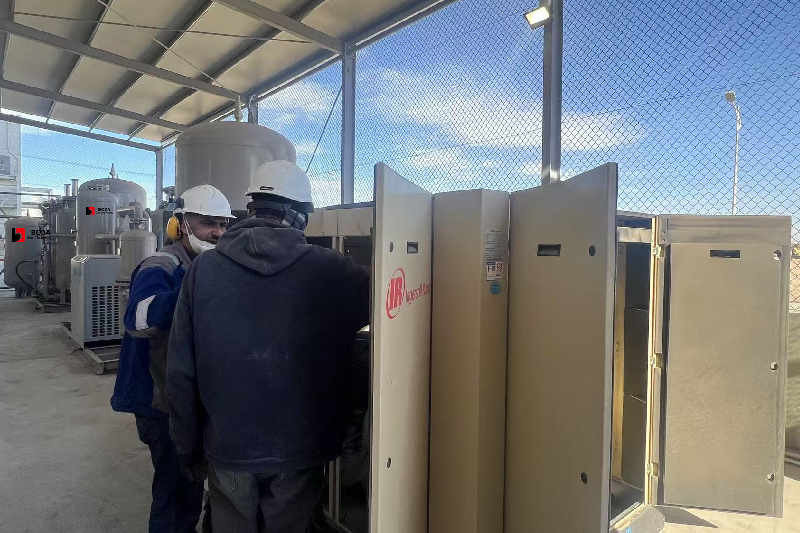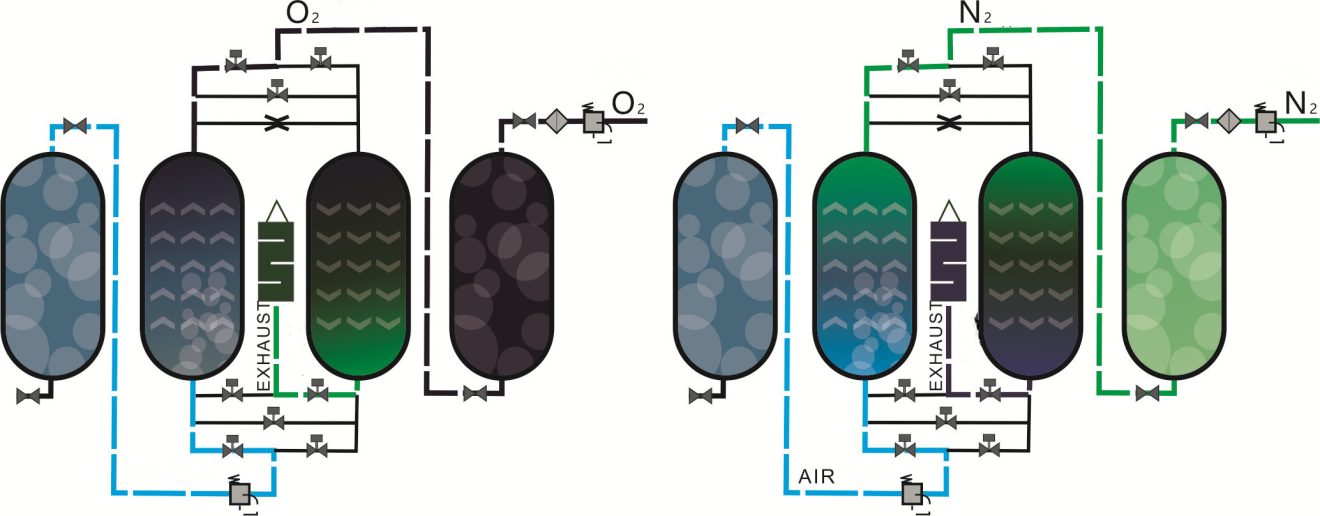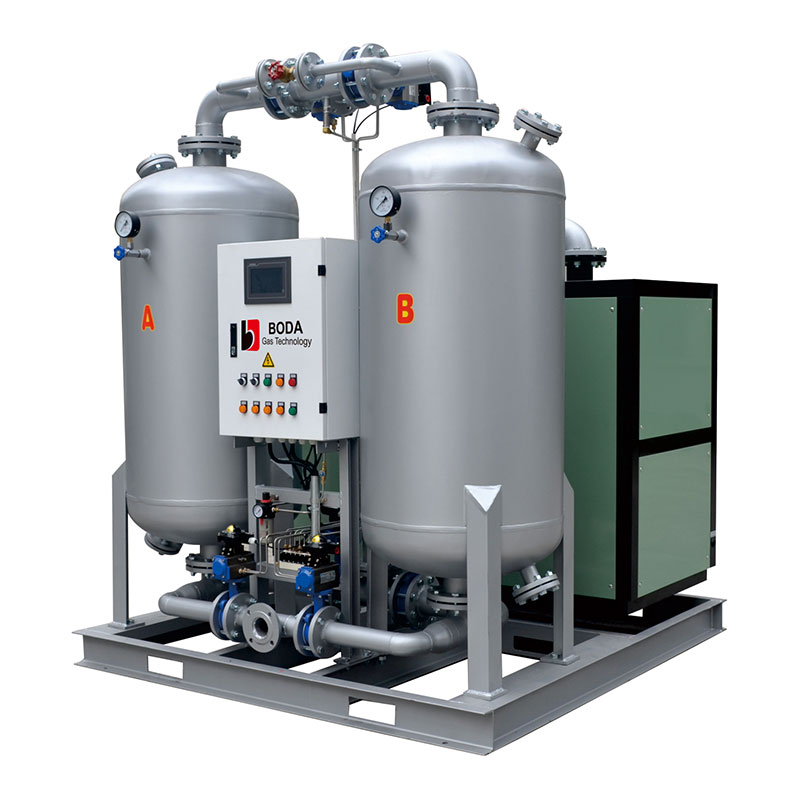PSA oxygen generators are widely used in medical, industrial, and home healthcare due to their high efficiency, cost-effectiveness, and safety. They are the ideal choice for obtaining high-purity oxygen.
An oxygen generator is a device that separates oxygen from compressed air using special selective adsorptive technology called pressure swing adsorption (PSA). The compressed air used in the oxygen generation process has a similar composition to ambient environmental air with 21% oxygen and 78% nitrogen.
Are you curious about how an oxygen generator works and its applications? This guide will walk you through the essential details you need to know about oxygen generators and their importance in various fields, including healthcare and industry. Read on to understand their functionality, components, and benefits to help you make an informed decision when purchasing an oxygen generator.
How do oxygen concentrators work?
An oxygen concentrator works by filtering out nitrogen from ambient air and delivering concentrated oxygen through a process called pressure swing adsorption (PSA). The air is compressed into a cylinder, where it flows through a sieve bed material that absorbs nitrogen and allows the oxygen to pass through. This technology helps provide purified oxygen for medical or industrial applications, ensuring a steady supply without the need for oxygen tanks. Oxygen concentrators offer a reliable and sustainable alternative to traditional methods of oxygen supply, especially in remote or cost-sensitive areas.

What is the purpose of an oxygen generator?
The primary purpose of an oxygen generator is to supply high-purity oxygen for various uses. Medical oxygen generators are used in hospitals, clinics, and home healthcare settings to provide supplemental oxygen to patients with respiratory issues. In industrial settings, oxygen generators support processes that require pure oxygen, such as metal cutting, welding, and combustion. The generator works efficiently to provide a continuous, on-demand supply of oxygen, eliminating the need for oxygen tanks, which require refilling and maintenance. With its energy efficiency and portability, an oxygen generator is the ideal solution for environments that need reliable and constant access to oxygen.
What Parts Make Up an Oxygen Generator?
An oxygen generator consists of several key components that work together to produce and deliver oxygen. The primary parts include:
- Compressor: The compressor draws in ambient air and compresses it to increase the air pressure before it enters the system.
- Air Dryer: This component removes moisture from the compressed air, as excessive moisture can affect the efficiency of the adsorption process.
- Adsorption Towers (Sieve Beds): These towers contain materials that adsorb nitrogen from the compressed air, allowing the oxygen to pass through. The most common materials used are zeolite molecular sieves.
- Valves: The valves control the flow of compressed air into and out of the adsorption towers and help regulate the pressure and airflow within the system.
- Oxygen Outlet: The purified oxygen exits the system and is delivered to the user via a mask, cannula, or other delivery methods.
These components work in harmony to ensure that the oxygen generator operates efficiently, delivering a consistent and purified oxygen supply for various applications.
How Does an Oxygen Generator Work for Industrial Use?
In industrial settings, an oxygen generator provides a steady and efficient supply of oxygen for processes such as combustion, welding, and metal cutting. The generator works by filtering nitrogen from the ambient air, which is then compressed and passed through adsorption towers filled with zeolite sieves. These sieves adsorb the nitrogen, leaving purified oxygen to flow into the system. The oxygen generated is used in industrial processes that require high purity oxygen for optimized performance. One of the key benefits of using an oxygen generator in industrial applications is its cost-effectiveness, as it eliminates the need for purchasing and storing oxygen tanks. Additionally, oxygen generators are reliable and provide a continuous supply of oxygen, making them ideal for industries like steel manufacturing, chemical production, and energy generation.

How long can an oxygen concentrator run continuously?
An oxygen concentrator can typically run continuously for 24 hours a day, 7 days a week, as long as it is properly maintained. However, the lifespan and performance of the concentrator may depend on several factors, including the model, usage, and maintenance. Generally, most portable oxygen concentrators and stationary units are designed for long-term use, with high durability and energy efficiency. It’s essential to follow the manufacturer’s guidelines for proper care and routine maintenance to ensure the concentrator operates at optimal efficiency. Over time, the sieve beds in the concentrator may need to be replaced, but with proper care, the unit can continue to run reliably for years.
Is it okay to run an oxygen concentrator 24/7?
Yes, it is generally safe to run an oxygen concentrator 24/7, especially if the unit is designed for continuous use. Many stationary oxygen concentrators are built for continuous operation and can deliver a steady supply of oxygen without interruption. However, it’s crucial to monitor the concentrator’s performance regularly to ensure it is functioning correctly. Some portable oxygen concentrators may have a lower duty cycle and may not be designed for continuous use. Always refer to the manufacturer’s specifications and guidelines to determine the appropriate usage duration for your specific model. Regular maintenance, such as cleaning filters and replacing sieve beds, will help ensure optimal performance.
Conclusion
Oxygen generators provide a reliable, efficient, and cost-effective solution for obtaining high-purity oxygen across various applications, from healthcare to industry.




